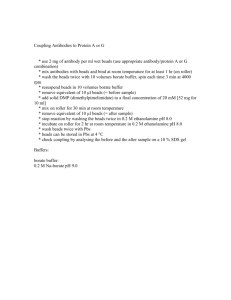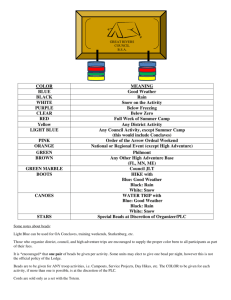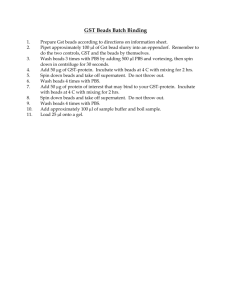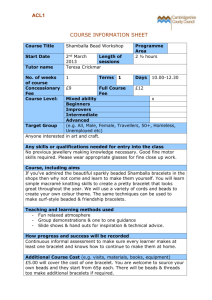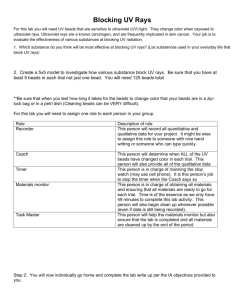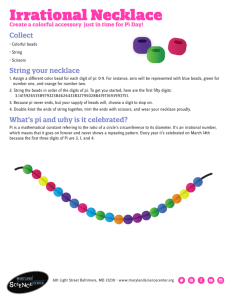Using IgM antibodies for IP
advertisement
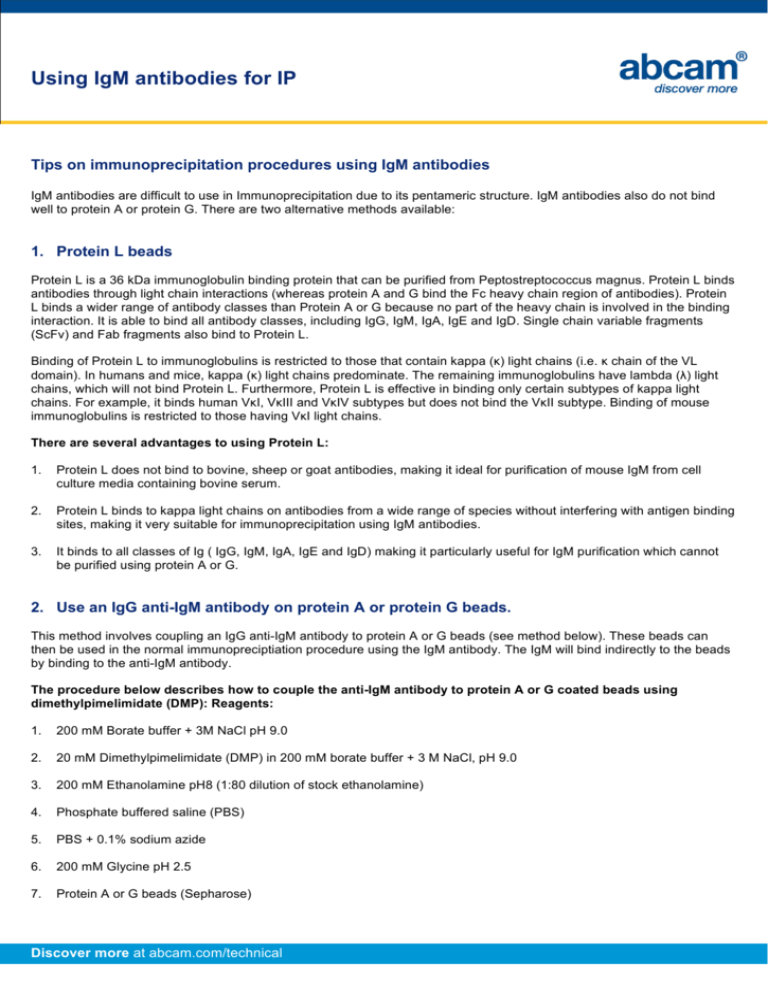
Using IgM antibodies for IP Tips on immunoprecipitation procedures using IgM antibodies IgM antibodies are difficult to use in Immunoprecipitation due to its pentameric structure. IgM antibodies also do not bind well to protein A or protein G. There are two alternative methods available: 1. Protein L beads Protein L is a 36 kDa immunoglobulin binding protein that can be purified from Peptostreptococcus magnus. Protein L binds antibodies through light chain interactions (whereas protein A and G bind the Fc heavy chain region of antibodies). Protein L binds a wider range of antibody classes than Protein A or G because no part of the heavy chain is involved in the binding interaction. It is able to bind all antibody classes, including IgG, IgM, IgA, IgE and IgD. Single chain variable fragments (ScFv) and Fab fragments also bind to Protein L. Binding of Protein L to immunoglobulins is restricted to those that contain kappa (κ) light chains (i.e. κ chain of the VL domain). In humans and mice, kappa (κ) light chains predominate. The remaining immunoglobulins have lambda (λ) light chains, which will not bind Protein L. Furthermore, Protein L is effective in binding only certain subtypes of kappa light chains. For example, it binds human VκI, VκIII and VκIV subtypes but does not bind the VκII subtype. Binding of mouse immunoglobulins is restricted to those having VκI light chains. There are several advantages to using Protein L: 1. Protein L does not bind to bovine, sheep or goat antibodies, making it ideal for purification of mouse IgM from cell culture media containing bovine serum. 2. Protein L binds to kappa light chains on antibodies from a wide range of species without interfering with antigen binding sites, making it very suitable for immunoprecipitation using IgM antibodies. 3. It binds to all classes of Ig ( IgG, IgM, IgA, IgE and IgD) making it particularly useful for IgM purification which cannot be purified using protein A or G. 2. Use an IgG anti-IgM antibody on protein A or protein G beads. This method involves coupling an IgG anti-IgM antibody to protein A or G beads (see method below). These beads can then be used in the normal immunopreciptiation procedure using the IgM antibody. The IgM will bind indirectly to the beads by binding to the anti-IgM antibody. The procedure below describes how to couple the anti-IgM antibody to protein A or G coated beads using dimethylpimelimidate (DMP): Reagents: 1. 200 mM Borate buffer + 3M NaCl pH 9.0 2. 20 mM Dimethylpimelimidate (DMP) in 200 mM borate buffer + 3 M NaCl, pH 9.0 3. 200 mM Ethanolamine pH8 (1:80 dilution of stock ethanolamine) 4. Phosphate buffered saline (PBS) 5. PBS + 0.1% sodium azide 6. 200 mM Glycine pH 2.5 7. Protein A or G beads (Sepharose) Discover more at abcam.com/technical Method We recommend using 2 mg of antibody per ml wet beads (use appropriate antibody/protein A or G combination). 1. Add 250 mg Protein A or G Sepharose beads (beads) to 2 ml PBS + 0.1% sodium azide, for 1 hr before use. This allows the beads to swell. 2. Mix the beads with an appropriate concentration of antibody for 2 hr at RT (using a rotator or roller). 3. Centrifuge at 2500 rpm for 5 mins. 4. Wash the beads twice in 10 X volume of 200 mM borate buffer + 3 M NaCl. 5. Resuspend the beads in 20 mM DMP. 6. Rotate/agitate the beads for 30 min at RT. 7. Centrifuge the beads at 2,500 rpm for 5 mins. 8. Wash the beads 2 X in 200 mM borate buffer + 3M NaCl. 9. Wash the beads 1 X in 20 mM ethanolamine. This stops the coupling reaction. 10. Resuspend the beads in 20 mM ethanolamine and rotate for 2 hr at RT. 11. Centrifuge the beads at 2,500 rpm for 5 min. 12. Wash the beads 2 X in PBS. 13. Wash the beads 2 X in 200 mM glycine. 14. Wash the beads 2 X in PBS. 15. The beads can be stored at 4°C in PBS + 0.1% sodium azide (Ratio of 1:1 PBS:beads). 16. These beads are now ready for use in immunoprecipitation with IgM antibody. From this point, proceed with the immunoprecipitation as described on our immunoprecipitation protocol. Discover more at abcam.com/technical
